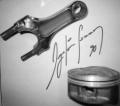-
 ABS triggering at walking pace?
ABS triggering at walking pace?
I'm experiencing an odd problem that feels like the ABS is triggering while braking at very slow speeds - literally just as I'm pulling up to a halt in traffic.
There is a brief chirrup from the footwell and the pedal pulses underfoot. After a couple of occurrences the ABS pump kicks in to recharge the accumulators.
It occurs fairly consistently when at low speed; I have not observed it while travelling at higher speeds.
On a couple of occasions the chirrup has sounded while I haven't been braking, but I haven't had my foot on the pedal to confirm whether it's been pulsing or not.
Any ideas?
I can see how a mismatch in wheel speed sensor outputs could trigger the ABS unnecessarily, but I'm surprised it's triggering at all at the kind of speeds involved here - 1 or 2 mph, maybe less.
-

Don't know the spec of your NSX but as you are saying that you can hear the ABS pump while driving, you are very likely to have the classic ABS.
You may be able to hear the ABS pump even with the upgraded ABS but it will be on leaving your garage and since it's so faint, you can't hear it on other occasions.
If you have the classic ABS, then very likely to be the same phenomenon that several owners experienced including myself.
My own experiences including the story of other NSX here;
http://www.nsxcb.co.uk/entry.php?65-ABS-Error-code-13
http://www.nsxcb.co.uk/entry.php?1194-ABS-error-code-12
It is caused by the signal quality issue on the w/speed sensor(s).
Depending on the number of faulty sensors involved, signal quality level and if your TCS is enabled, it may activate the TCS (bog down) but very unlikely.
It will trigger the ABS solenoid and kick back the brake pedal just when you are about to stop.
On some NSX, I didn't have to touch the brake pedal yet the solenoid clicked several times by simply slowing down while in 2nd gear going through the residential area.
The problem with this failure mode with the classic ABS is that most likely, you won't trigger the ABS warning light and thus, you won't know which corner is at fault.
The brain power is not strong/fast enough to detect this failure mode.
On the other hand, the upgraded ABS brain can detect it.
Because it's signal quality issue and not open/short circuit failure, you are very likely not to see any issues when measuring the sensor resistance using the multimeter.
If you have oscilloscope, you may be able to see the abnormal waveform while spinning the wheel but the issue has to be permanent and not intermittent.
Also, for the case of RR w/speed sensor, you must check the big non-WPC connector inside the boot behind the carpet at the forward left section as you may have broken connector terminal there.
If you drive several weeks/months/years, you may be able to trigger the ABS warning light even with the classic ABS and able to find out which sensor is faulty but depending on the kick back level at the brake pedal, it's not safe.
With one NSX, the kick back was so strong and persistent that every time when I was about to stop, the car moved further forward because of the sudden loss of brake pressure. Scary....
You don't want driving any cars under such condition….
Hope some of the w/speed sensors were replaced in the past so that you can 'guess' which one or ones at fault.
Please remember to check the connector inside the boot for the RR one.
Based on limited experiences so can't say for sure but it seems that this issue can be highlighted/exaggerated by applying thermal shock to the w/speed sensor.
Even with the weak classic ABS brain, the level of thermal shock could push the sensor signal beyond the OK/NG threshold that it may trigger the ABS warning light.
Therefore, if you can spray freezing cold electronics testing spray at the back of each sensors and then start driving immediately, you may (or may not) be able to trigger the ABS warning light.
It would have been much easier if it were still in that cold 'beast from the east' weather.....
If you have cheap hand held oscilloscope, you can do it much safer with the car on the lift.
You don't need to power up the car for monitoring the sensor signal.
Kaz
Last edited by Kaz-kzukNA1; 21-03-2018 at 01:47 PM.
Reason: extra info
-

Thanks Kaz - superb summary of the problem!
Now to actually get started on hunting it down . . .
 Posting Permissions
Posting Permissions
- You may not post new threads
- You may not post replies
- You may not post attachments
- You may not edit your posts
-
Forum Rules




 Reply With Quote
Reply With Quote
